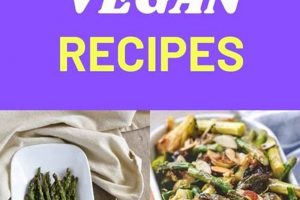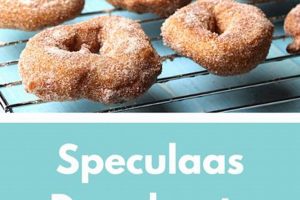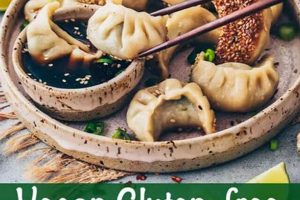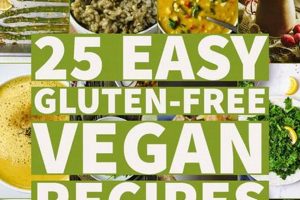Culinary creations that exclude all animal products and gluten represent a growing sector within the food industry. These specialized items cater to individuals with dietary restrictions, ethical eating preferences, or health-conscious lifestyles. An example is a dairy-free chocolate cake made with almond flour and sweetened with maple syrup, ensuring suitability for both vegan and gluten-intolerant consumers.
The appeal of such options lies in their inclusivity and potential health benefits. They offer alternatives to traditional baked goods, allowing individuals with specific dietary needs to enjoy treats without compromising their principles or well-being. Historically, finding palatable substitutes for common allergens and animal products presented a significant challenge. However, advancements in food science and readily available alternative ingredients have broadened the possibilities for satisfying and diverse recipes.
The following sections will delve into the specific ingredients, preparation techniques, and nutritional considerations relevant to producing these specialized food items. Further discussion will explore the market trends and consumer demand that drive the ongoing innovation in this culinary field.
Tips for Crafting Exceptional Vegan and Gluten-Free Confections
Achieving optimal results in the realm of vegan and gluten-free baking requires careful attention to ingredient selection and technique. The following recommendations aim to guide practitioners toward consistently producing high-quality products.
Tip 1: Employ High-Quality Gluten-Free Flour Blends: Different blends possess varying ratios of starches and gums. Selecting a blend formulated for baking is crucial for achieving the desired texture. Potato starch, tapioca starch, and brown rice flour are common components.
Tip 2: Incorporate Binding Agents: The absence of gluten necessitates the inclusion of alternative binding agents. Flaxseed meal or chia seeds, when mixed with water, form a gel that replicates the binding properties of gluten. Psyllium husk is another effective option, contributing both binding and fiber.
Tip 3: Prioritize Accurate Measurement: Gluten-free flours behave differently than wheat flour. Measuring by weight, rather than volume, ensures greater consistency and precision in recipes.
Tip 4: Control Hydration Levels: Gluten-free baked goods often require more moisture than their conventional counterparts. Experimenting with incremental increases in liquid, such as non-dairy milk or applesauce, can prevent dryness.
Tip 5: Adjust Baking Temperatures and Times: Gluten-free items may brown more quickly. Reducing oven temperature by 25 degrees Fahrenheit and monitoring baking progress closely is recommended. A toothpick inserted into the center should emerge clean, or with only a few moist crumbs attached.
Tip 6: Consider Gum Alternatives: While xanthan gum is frequently used in gluten-free baking, individuals may be sensitive to it. Guar gum or additional flaxseed meal can serve as viable substitutes.
Tip 7: Explore Nut and Seed Butters: These ingredients contribute moisture, richness, and structure. Almond butter, cashew butter, and sunflower seed butter can add unique flavor profiles while enhancing the overall texture.
By meticulously adhering to these guidelines, it is possible to produce vegan and gluten-free treats that are indistinguishable from, or even superior to, their traditional counterparts in terms of taste and texture. Skillful execution unlocks a wider range of culinary possibilities for individuals with specific dietary needs.
The subsequent section will address common challenges encountered in vegan and gluten-free baking, offering practical solutions for overcoming these obstacles and refining one’s approach to this specialized culinary domain.
1. Ingredients
The selection and utilization of components are paramount in formulating successful vegan and gluten-free confections. Ingredient choices dictate the texture, flavor profile, nutritional value, and overall suitability of these specialized treats, directly influencing their appeal and accessibility.
- Gluten-Free Flour Alternatives
Wheat flour, the conventional base for baked goods, must be replaced with alternative flours that lack gluten. Common options include rice flour (brown and white), almond flour, tapioca starch, potato starch, and oat flour (certified gluten-free). The specific blend of flours employed significantly affects the final product’s texture, ranging from light and airy to dense and crumbly. For instance, using solely almond flour results in a moister, denser product compared to a blend incorporating rice flour and tapioca starch.
- Vegan Egg Replacers
Eggs contribute binding, leavening, and moisture in traditional baking. In vegan recipes, these functionalities must be replicated using plant-based alternatives. Flaxseed meal or chia seeds mixed with water create a gel that provides binding. Applesauce or mashed banana can add moisture. Baking powder and baking soda, often used in conjunction with an acid like vinegar or lemon juice, provide leavening. The choice of egg replacer influences the final texture and flavor; flaxseed meal imparts a slightly nutty flavor, while applesauce adds subtle sweetness.
- Dairy-Free Fat Replacements
Butter and milk contribute fat, moisture, and flavor to baked goods. Vegan alternatives include plant-based oils (coconut oil, olive oil, canola oil), vegan butter substitutes, and plant-based milks (almond milk, soy milk, oat milk). Each option possesses unique characteristics. Coconut oil, for example, can impart a distinct coconut flavor, while olive oil offers a savory note. Vegan butter substitutes are often formulated to mimic the taste and texture of dairy butter, providing a more familiar flavor profile.
- Sweeteners
Conventional refined sugars can be used. Alternatively, other sources include maple syrup, agave nectar, coconut sugar, and stevia can provide sweetness while offering varying degrees of glycemic impact and flavor complexity. Maple syrup contributes a distinctive caramel-like flavor, while stevia offers intense sweetness with minimal caloric impact.
The careful selection and balanced combination of these components are vital for achieving desirable characteristics in vegan and gluten-free baked goods. Mastery of alternative ingredient properties allows for the creation of treats that cater to specific dietary requirements while maintaining appealing taste and texture profiles. The continued exploration of innovative ingredients will further expand the possibilities within this specialized culinary field.
2. Texture
Texture plays a crucial role in the overall sensory experience of food, particularly within the realm of vegan and gluten-free confections. The absence of gluten and animal products presents unique challenges in replicating the familiar textures of traditional baked goods. Achieving desirable textural qualities is paramount for consumer acceptance and satisfaction.
- Role of Gluten in Traditional Baked Goods
Gluten, a protein composite found in wheat, barley, and rye, provides elasticity and structure to dough. It enables the formation of air pockets, resulting in a light and airy texture. In its absence, vegan and gluten-free recipes require alternative binding agents and structural components to mimic these properties. The lack of gluten often leads to a denser, crumblier texture if not properly addressed.
- Importance of Starch Blends
Gluten-free flour blends typically incorporate various starches, such as tapioca starch, potato starch, and cornstarch, to achieve a desired texture. Tapioca starch contributes to a chewy texture, while potato starch provides moisture and softness. The ratio of these starches is crucial in creating a balanced texture, preventing the final product from being either too gummy or too dry. Success often lies in the careful calibration of starches to achieve the optimal balance.
- Impact of Fat Content and Type
Fats contribute to tenderness and moisture in baked goods. Vegan recipes rely on plant-based fats, such as coconut oil, vegetable oil, or vegan butter substitutes. The type of fat used significantly influences the texture. Coconut oil, for instance, solidifies at cooler temperatures, resulting in a firmer texture compared to liquid oils. Additionally, the creaming method, common in traditional baking, may need to be adapted or replaced with alternative techniques to properly incorporate fats into vegan doughs and batters.
- Influence of Binding Agents
Vegan egg replacers, such as flaxseed meal or chia seeds, provide binding properties that mimic the function of eggs. These ingredients absorb water and form a gel-like consistency, contributing to the structure and moisture of the final product. However, overuse of binding agents can lead to a gummy or dense texture, while insufficient use may result in a crumbly or dry consistency. Precise measurement and careful incorporation are essential for achieving the desired texture.
Achieving the correct texture in vegan and gluten-free treats is a complex interplay of ingredient selection, proportions, and preparation techniques. The insights shared contribute to the ongoing innovation and refinement within this specialized culinary domain.
3. Flavor Profiles
The characterization of tastes and aromas, representing a complex interplay of sensory perceptions, is a critical aspect of any culinary creation. This consideration gains particular significance in the realm of vegan and gluten-free treats, where the absence of conventional ingredients necessitates a strategic approach to flavor development and enhancement.
- Impact of Alternative Flours on Flavor
The substitution of wheat flour with gluten-free alternatives introduces distinct flavor nuances. Almond flour imparts a nutty sweetness, while brown rice flour can lend a slightly earthy note. These inherent flavors must be carefully considered and balanced with other ingredients to achieve a harmonious flavor profile. Overreliance on a single gluten-free flour can lead to a monotonous or undesirable taste experience, highlighting the importance of blending flours to create a more complex flavor foundation.
- Enhancement Through Spices and Extracts
Spices and extracts play a vital role in amplifying and complementing the base flavors of vegan and gluten-free treats. Vanilla extract, cinnamon, nutmeg, and cardamom can add warmth and depth to baked goods. Citrus zest provides brightness and acidity, counteracting the potentially bland taste of some gluten-free flours. Strategic use of these flavor enhancers can elevate the overall sensory experience and create more memorable and satisfying treats. For example, adding a touch of cardamom to a gluten-free vegan carrot cake enhances its inherent sweetness and spice notes.
- Balancing Sweetness with Other Sensations
The perception of sweetness is often intensified in the absence of gluten, requiring careful modulation to prevent an overly sugary or cloying taste. Incorporating contrasting flavors, such as bitterness (dark chocolate, coffee), acidity (lemon juice, apple cider vinegar), or saltiness (sea salt flakes), can create a more balanced and nuanced flavor profile. For example, a vegan and gluten-free chocolate brownie benefits from a sprinkle of sea salt, which enhances the richness of the chocolate and reduces the intensity of the sweetness.
- Leveraging Natural Sweeteners’ Unique Flavors
Natural sweeteners, such as maple syrup, agave nectar, and coconut sugar, possess distinct flavor characteristics that can contribute to the overall complexity of vegan and gluten-free treats. Maple syrup lends a caramel-like flavor, while agave nectar offers a more neutral sweetness. Coconut sugar imparts a subtle butterscotch note. These sweeteners not only provide sweetness but also add depth and dimension to the flavor profile. The choice of sweetener should be carefully considered to complement the other ingredients and achieve the desired taste.
Mastering the art of flavor development in vegan and gluten-free treats requires a deep understanding of ingredient interactions and a strategic approach to flavor layering. By carefully considering the impact of alternative flours, spices, sweeteners, and other flavor enhancers, it is possible to create specialized desserts that are both delicious and satisfying, despite their dietary restrictions.
4. Nutritional Value
The assessment of nutritional content is paramount when considering vegan and gluten-free confections. The absence of animal products and gluten necessitates careful formulation to ensure adequate intake of essential nutrients. Understanding the nutritional implications of ingredient substitutions is critical for creating healthful and balanced treats.
- Macronutrient Profile
The distribution of carbohydrates, proteins, and fats is a key consideration. Gluten-free flours often have a lower protein content than wheat flour, requiring the incorporation of protein-rich ingredients such as nuts, seeds, or legumes. Similarly, the selection of fats impacts the overall nutritional value. Unsaturated fats from sources like avocados or nuts are preferable to saturated fats from coconut oil. Maintaining a balanced macronutrient profile is essential for satiety and overall health.
- Micronutrient Content
Vegan diets may require attention to specific micronutrients, including vitamin B12, iron, calcium, and vitamin D. Gluten-free flours may also lack certain vitamins and minerals present in wheat flour. Fortification of ingredients or the inclusion of nutrient-dense foods, such as leafy greens or fortified plant-based milk, can help address these deficiencies. Regularly consuming a variety of nutrient-rich ingredients is crucial for meeting micronutrient needs.
- Fiber Intake
Gluten-free diets can be low in fiber if not carefully planned. Incorporating high-fiber ingredients, such as oats (certified gluten-free), psyllium husk, flax seeds, or fruits and vegetables, is essential for promoting digestive health and regulating blood sugar levels. Adequate fiber intake contributes to satiety and can help mitigate the potential for overconsumption of sugary treats.
- Sugar Content and Glycemic Index
Many conventional confections are high in refined sugars, which can lead to rapid spikes in blood sugar levels. Vegan and gluten-free treats are not exempt from this concern. Selecting natural sweeteners, such as maple syrup or coconut sugar, and using them in moderation can help mitigate this effect. Additionally, incorporating ingredients with a lower glycemic index, such as nuts or whole grains, can help stabilize blood sugar levels and provide sustained energy.
The nutritional value of vegan and gluten-free treats is contingent upon informed ingredient selection and mindful formulation. Prioritizing whole, unprocessed foods and balancing macronutrient and micronutrient profiles allows for the creation of specialized confections that can be enjoyed as part of a healthful diet. Further research and development are necessary to optimize the nutritional content of these treats and promote consumer well-being.
5. Allergen Control
The implementation of stringent allergen control measures is of paramount importance in the production of vegan and gluten-free treats. These food items, by their very nature, cater to individuals with specific dietary restrictions and sensitivities, necessitating rigorous protocols to prevent cross-contamination and ensure consumer safety.
- Ingredient Sourcing and Verification
The initial step in allergen control involves meticulous ingredient sourcing. Suppliers must provide certifications guaranteeing the absence of specified allergens, including but not limited to nuts, soy, and dairy, in both the raw materials and the production environment. Verification procedures, such as laboratory testing, should be implemented to confirm the accuracy of these certifications. For example, almond flour used in gluten-free vegan cookies must be certified as produced in a nut-free facility to prevent cross-contamination for individuals with peanut allergies. This meticulous verification is crucial to protect susceptible individuals.
- Segregation of Production Lines
To minimize the risk of cross-contamination, dedicated production lines and equipment should be employed for the manufacture of vegan and gluten-free products. These lines must be physically separated from those processing items containing common allergens. Where dedicated lines are not feasible, thorough cleaning and sanitation procedures must be implemented between production runs. The efficacy of cleaning protocols should be validated through allergen testing to ensure that residual allergen levels are below acceptable thresholds. The consequences of failing to segregate lines can be severe, potentially leading to allergic reactions in consumers.
- Employee Training and Awareness
Comprehensive training programs for all personnel involved in the production process are essential. Employees must be educated on the importance of allergen control, proper handling procedures, and the potential consequences of cross-contamination. Training should include instruction on reading ingredient labels, identifying potential allergen sources, and adhering to strict hygiene protocols. Regular refresher courses and audits are necessary to maintain a high level of awareness and compliance. The human element is a critical factor in effective allergen control.
- Labeling and Transparency
Accurate and transparent labeling is paramount for informing consumers about the allergen content of vegan and gluten-free treats. Ingredient lists must clearly identify all components, including any potential allergens. Clear and concise precautionary statements, such as “May contain traces of nuts,” should be included when cross-contamination risks exist despite best practices. Transparent labeling empowers consumers to make informed choices and avoid products that may pose a risk to their health. Ambiguous or misleading labeling can have serious consequences for individuals with allergies.
The multifaceted approach to allergen control, encompassing ingredient verification, production segregation, employee training, and transparent labeling, is indispensable for ensuring the safety and well-being of consumers who rely on vegan and gluten-free products. The successful implementation of these measures requires a commitment to rigorous standards and continuous improvement, reflecting the critical importance of safeguarding vulnerable populations.
6. Shelf Life
The duration for which vegan and gluten-free treats maintain their desired quality and safety for consumption is a critical factor influencing their market viability and consumer satisfaction. Due to the absence of traditional preservatives found in conventional baked goods, coupled with the inherent characteristics of alternative ingredients, these specialized items often present unique challenges in achieving extended shelf life. This limitation can affect production planning, distribution strategies, and ultimately, the economic feasibility of producing and selling these treats.
Several factors contribute to the shortened shelf life commonly observed in this category. The use of gluten-free flours, such as almond or rice flour, generally results in products that dry out more quickly than those made with wheat flour. Similarly, the substitution of dairy and eggs with plant-based alternatives can impact moisture retention and microbial stability. For instance, a vegan cake made with applesauce as an egg replacement might exhibit a shorter shelf life compared to one made with traditional eggs due to the higher water activity and potential for mold growth. Proper storage conditions, including temperature and humidity control, are therefore paramount in mitigating spoilage and preserving product quality for as long as possible.
Extending the shelf life of vegan and gluten-free treats requires a multifaceted approach. This may involve the use of natural preservatives, such as rosemary extract or ascorbic acid, modified atmosphere packaging, and optimized recipe formulations that balance moisture content and microbial activity. Ultimately, understanding the interplay between ingredient properties, processing techniques, and storage conditions is essential for maximizing the shelf life of these specialized products and ensuring their safe consumption. Further research and development in this area are crucial for addressing the limitations currently faced by manufacturers and retailers in this growing segment of the food industry.
7. Presentation
The visual appeal of food significantly influences consumer perception and desirability, a principle that holds particular relevance for vegan and gluten-free treats. Effective presentation transcends mere aesthetics; it communicates the quality, care, and inherent value of these specialized culinary offerings, particularly important when addressing potential skepticism or misconceptions surrounding dietary alternatives.
- Color Palette and Garnishes
The use of vibrant, natural colors derived from fruits, vegetables, and spices enhances visual appeal and reinforces the perception of healthfulness. Strategic garnishing with fresh herbs, edible flowers, or precisely placed fruit slices elevates the presentation, signaling attention to detail and premium quality. For example, a vegan and gluten-free chocolate cake adorned with fresh raspberries and a dusting of cocoa powder presents a more enticing image than a plain, unadorned cake. These visual cues contribute to the overall sensory experience.
- Texture and Form
The visual texture of vegan and gluten-free treats is critical for conveying information about their eating quality. A smooth, glossy surface on a frosting or a delicate crumb structure visible in a cake slice suggests a pleasing mouthfeel. Attention to detail in shaping and forming these treats, whether through precise cutting, careful piping, or the use of decorative molds, communicates a sense of craftsmanship and care. For instance, neatly arranged rows of vegan and gluten-free macarons, each with a consistent shape and vibrant color, create a visually appealing and professional presentation.
- Packaging and Display
The manner in which vegan and gluten-free treats are packaged and displayed significantly impacts consumer perception. Transparent packaging allows customers to visually assess the product’s quality and appearance. Thoughtful arrangement on shelves, use of attractive signage, and highlighting of key features, such as “gluten-free” or “vegan,” attract attention and convey value. A bakery showcasing its vegan and gluten-free cupcakes in an elegant display case with clear labeling enhances their perceived desirability compared to those displayed in a cluttered or unorganized manner.
- Photography and Digital Marketing
High-quality photography is essential for promoting vegan and gluten-free treats online. Visually appealing images showcasing the product’s texture, color, and presentation can effectively communicate its appeal to a wider audience. Digital marketing campaigns should leverage these images to highlight the culinary artistry and nutritional benefits of these specialized offerings. A professionally styled photograph of a vegan and gluten-free cheesecake, showcasing its creamy texture and vibrant fruit topping, can be significantly more effective in driving sales than a poorly lit, unappetizing image.
These elements, when combined effectively, create a cohesive and compelling visual narrative that elevates vegan and gluten-free treats beyond mere dietary alternatives. By prioritizing thoughtful presentation, producers can enhance consumer appeal, communicate product value, and effectively compete in a market increasingly driven by visual cues and sensory experiences.
Frequently Asked Questions
The following section addresses common inquiries regarding vegan and gluten-free treats, providing factual information to clarify misconceptions and offer practical guidance.
Question 1: Are all vegan treats also gluten-free?
No. The terms “vegan” and “gluten-free” refer to distinct dietary restrictions. Veganism excludes all animal products, while a gluten-free diet excludes gluten, a protein found in wheat, barley, and rye. A treat may be vegan without being gluten-free, and vice versa.
Question 2: Do vegan and gluten-free treats taste the same as traditional treats?
While advancements in recipe development have minimized the differences, subtle variations in taste and texture may exist. The use of alternative flours and sweeteners can impart unique flavor profiles. However, skilled bakers can create vegan and gluten-free treats that closely resemble, or even surpass, the taste of their traditional counterparts.
Question 3: Are vegan and gluten-free treats healthier than traditional treats?
Not necessarily. The nutritional value of any treat depends on its ingredients. Vegan and gluten-free treats can be high in sugar and fat, just like traditional treats. However, they can also be formulated with nutrient-rich ingredients, such as fruits, vegetables, nuts, and seeds, to enhance their nutritional profile. Careful attention to ingredient selection is crucial.
Question 4: How can one identify a genuinely vegan and gluten-free treat?
Thoroughly examine the ingredient list. Look for certifications from reputable organizations that verify vegan and gluten-free status. Be wary of vague labeling or ambiguous language. When in doubt, contact the manufacturer or retailer for clarification.
Question 5: What are common challenges in baking vegan and gluten-free treats?
Replacing gluten and animal products presents technical challenges. Gluten provides structure and elasticity, while eggs contribute binding and leavening. Successful vegan and gluten-free baking requires mastering alternative binding agents, leavening techniques, and moisture management strategies.
Question 6: Where can one purchase vegan and gluten-free treats?
These items are increasingly available in supermarkets, health food stores, and specialty bakeries. Online retailers also offer a wide selection. Availability may vary depending on geographic location.
In summary, vegan and gluten-free treats offer a viable option for individuals with specific dietary needs or preferences. Informed consumers should carefully evaluate ingredient lists and nutritional information to make choices that align with their individual health goals.
The subsequent section will explore emerging trends and innovations in the realm of vegan and gluten-free culinary arts.
Concluding Observations on Vegan and Gluten-Free Treats
The preceding analysis has explored the multifaceted nature of vegan and gluten-free treats, addressing ingredient selection, textural considerations, flavor profiles, nutritional value, allergen control, shelf life, and presentation. These specialized food items represent a significant sector within the broader culinary landscape, driven by increasing consumer awareness of dietary restrictions and ethical eating practices. The successful formulation of vegan and gluten-free treats demands a rigorous understanding of ingredient properties and the application of specialized techniques to overcome inherent challenges.
Continued innovation in ingredient technology and culinary expertise holds the potential to further refine the quality and accessibility of vegan and gluten-free treats. The industry must prioritize transparency in labeling and adhere to stringent safety protocols to ensure consumer confidence. As dietary needs and preferences evolve, the ongoing development and refinement of these specialized confections will remain a critical area of focus within the food sector, contributing to a more inclusive and diverse culinary environment.




![Easy Vegan Gluten-Free Muffins Recipe [Delicious & Free!] Discover Delicious Vegan Food, Beauty Swaps, and Zero-Waste Tips for a Greener Life Easy Vegan Gluten-Free Muffins Recipe [Delicious & Free!] | Discover Delicious Vegan Food, Beauty Swaps, and Zero-Waste Tips for a Greener Life](https://thisvegangirl.com/wp-content/uploads/2025/10/th-931-300x200.jpg)


